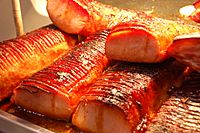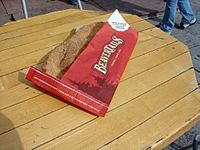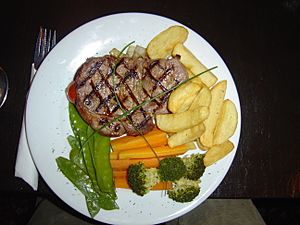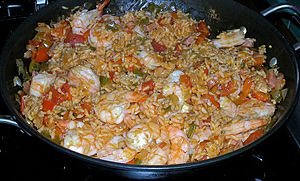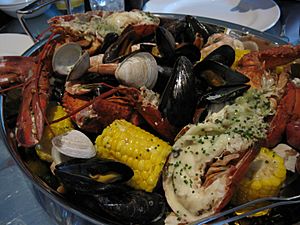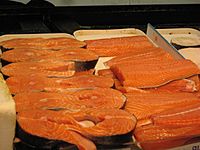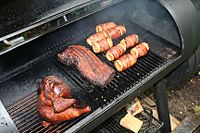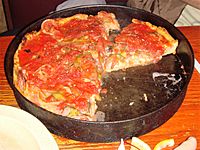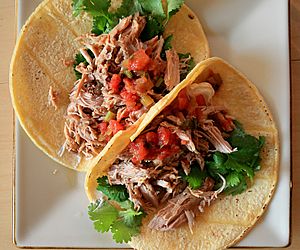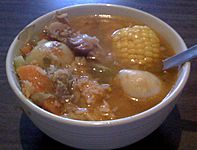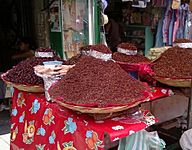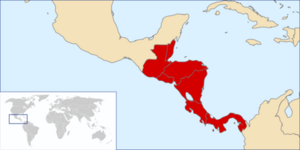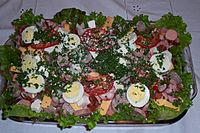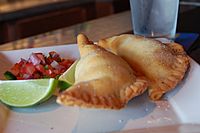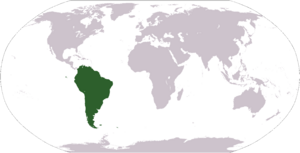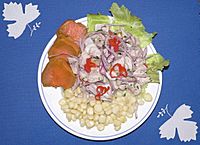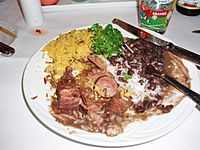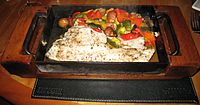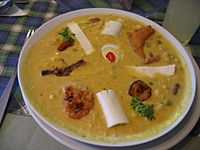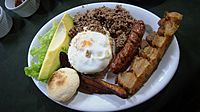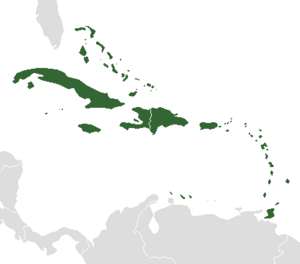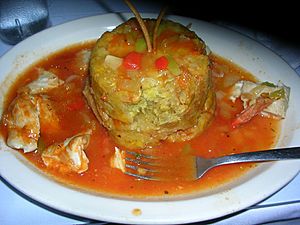List of cuisines of the Americas facts for kids
Have you ever wondered about the amazing foods people eat across North and South America? A cuisine is a special way of cooking and traditions often linked to a certain culture. The foods you find in the Americas are mostly based on what immigrants brought from their home countries, especially from Europe. But over time, these European cooking styles changed. People added local ingredients and new cooking methods, making them unique to the Americas.
Contents
North American Cuisine
-
- Canadian cuisine is very diverse, changing a lot from one region to another. It's like a "smorgasbord" of different foods, not just one type. Traditional English Canadian food is similar to British cooking. French Canadian food comes from 16th-century French cuisine and the meals fur traders ate in winter. Many immigrants from Europe and Asia in recent centuries have also added to Canada's food traditions. Popular Canadian foods include poutine and butter tarts. Quebec in Canada makes the most maple syrup in the world. The maple leaf is even on Canada's flag!
- Canadian foods and dishes
-
Canadian bacon, also called peameal bacon, is made from pork loin.
-
BeaverTail is a fried dough pastry from Quebec. It looks like a beaver's tail, which is a Canadian symbol.
-
Fish and brewis with scrunchions is a traditional meal from Newfoundland. It has codfish and hard bread.
-
A bottle of maple syrup from Quebec, Canada.
-
-
- Cuisine of Quebec is known for unique dishes. Famous foods include tourtières (meat pies), pea soup, and baked beans. Maple products like maple syrup and Pouding chômeur are also very popular.
-
-
-
- Maritime Provinces food has special dishes from Acadians, First Nations, and English settlers. Many of these foods use seafood or vegetables that could be stored easily for winter.
- Toronto is a big city with many different cultures. You can find foods from all over the world there. Different neighborhoods often specialize in certain types of food.
- Some other Canadian regional foods are:
-
-
- American cuisine (USA) has a long history. It started with the diverse cooking styles of Native Americans. When Europeans arrived, new ingredients and cooking methods were added. Later, immigrants from around the world brought their own foods, creating many unique regional cuisines across the country. Cheese and wine are also important parts of American food culture.
-
-
- Midwestern American cuisine is influenced by foods from Central, Northern, and Eastern Europe. It also uses many local ingredients.
- Northeastern American cuisines include the six states of Connecticut, Maine, Massachusetts, New Hampshire, Rhode Island, and Vermont. Native American cooking styles mixed with what early colonists brought.
-
- Cuisine of New York City has many foods from different ethnic groups. Almost every type of food can be found in New York City, especially in its various ethnic neighborhoods.
- Southern American cuisines are found in states south of the Mason-Dixon line and west to Texas. These foods blend different traditions. See also: Soul food.
-
- Cajun cuisine
- Louisiana Creole cuisine mixes French, Spanish, Portuguese, Italian, Greek, Asian Indian, Native American, African, and Southern cooking styles.
- Southwestern American cuisine is inspired by the rustic cooking of the Southwest. It combines recipes from Spanish colonial settlers, cowboys, Native Americans, and Mexicans. There is a lot of variety in this food across the Southwestern states.
- Western American cuisine is different from the rest of the U.S. It includes states west of Texas, Kansas, Missouri, and Nebraska. People in this region are increasingly interested in using local and sustainable foods. Native American cultures also have a big influence, especially in the Northwest.
-
- California cuisine focuses on mixing different cooking styles and using fresh, local ingredients.
- Hawaiian cuisine today is a mix of many foods brought by immigrants to the Hawaiian Islands. These include influences from American, Chinese, Filipino, Japanese, Korean, Polynesian, and Portuguese cooking. A common meal is the plate lunch, which often has two scoops of rice, macaroni salad, and a main dish like a Loco Moco or kalua pig.
- Pacific Northwest cuisine is found in Oregon, Washington, Alaska, British Columbia, and southern Yukon. It shows influences from Asian and Native American traditions.
- Fusion cuisine blends different cooking styles.
- Other American food types:
- Regional foods and cuisines:
-
- Additional U.S. foods and dishes
-
Salmon is widely available in the Pacific Northwest.
-
New England clam chowder.
-
Chicago-style deep-dish pizza from the original Pizzeria Uno location.
-
- Mexican cuisine changes a lot by region because Mexico is large and diverse. Different climates, geography, and indigenous groups, plus Spanish influence, created this variety. Northern Mexico is known for beef and meat dishes like arrachera. The main foods in Mexican cuisine are usually corn and beans. Corn is used to make masa, a dough for tamales, tortillas, and gorditas. Squash and chili peppers are also very important. Honey is used in many Mexican dishes and drinks. UNESCO has added Mexican cuisine to its list of "Intangible Cultural Heritage of Humanity".
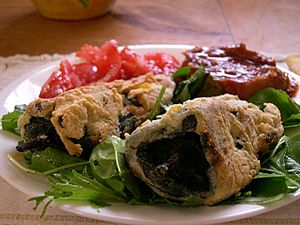
-
-
- Central Mexico's food is influenced by the rest of the country. It also has unique dishes like barbacoa, pozole, menudo, and carnitas.
- Southeastern Mexico is known for spicy vegetable and chicken dishes. Its food has a strong Caribbean influence because of its location. Seafood is popular in states along the Pacific Ocean or the Gulf of Mexico. The Gulf is famous for its fish dishes, like à la veracruzana.
- In villages, you can find more unusual dishes. These are cooked in the Aztec or Mayan style, called comida prehispánica. Ingredients can include iguana, rattlesnake, deer, spider monkey, chapulines (grasshoppers), and other insects.
- Recently, Baja Med cuisine has become popular in Tijuana and Baja California. It mixes Mexican and Mediterranean flavors. Other world cuisines are also becoming popular in Mexico, leading to Mexican fusion dishes. For example, sushi in Mexico often has mango or tamarind sauces. It's often served with soy sauce mixed with serrano chili, or with habanero and chipotle peppers.
- Regional Mexican foods:
-
- Carne asada, thin or thick pieces of meat, usually beef, often marinated.
- Chipotle, a smoke-dried jalapeño chili pepper.
- Chocolate: The word chocolate comes from Mexico's Aztec cuisine. The Maya civilization grew cacao trees and used the seeds to make a frothy, bitter drink called xocoatl. It was often flavored with vanilla, chili pepper, and achiote. Chocolate was also used as money. Today, chocolate is in many Mexican foods, from savory dishes like mole to traditional Mexican hot chocolate.
-
- Additional Mexican foods and dishes
-
Caldo de res is a Mexican dish with corn, green beans, potatoes, carrots, cabbage, and cilantro.
-
Chapulines (roasted grasshoppers) for sale in Oaxaca, Mexico.
-
- Mexican wine
Central American Cuisine
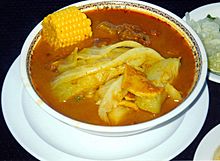
- Central American cuisine often features dishes made from maize (corn). Common foods include tortillas, tamales, pupusas, and various salsas. Other popular condiments are guacamole, pico de gallo, mole, and chimichurri.
-
- Belizean cuisine mixes foods from Mayan, Garifuna, Spanish, Creole, Chinese, British, Caribbean, and American cultures. Beans, tortillas, cheese, chicken, rice, and seafood are common.
- Costa Rican cuisine often features gallo pinto, which is rice and black beans. Tortillas, plantains, fish, beef, and chicken are also part of the food culture. Casado is a traditional meal with meat, tortillas, and sides like black beans and rice. Refrescos are cold fruit smoothies made with fruit and milk or water.
- Salvadoran cuisine comes from the Maya, Lenca, and Pipil people. It is also influenced by Spanish cooking. Empanadas, tamales, and pupusas are very common. Seafood is popular because of El Salvador's long coastline.
- Guatemalan cuisine was shaped by the Mayan Empire, Spanish rule, and modern influences. Guatemala has 22 regions, each with its own food varieties.
- Honduran cuisine is a mix of African, Spanish, and indigenous foods. Coconut is used in both sweet and savory dishes. Regional specialties include fried fish, tamales, carne asada, and baleadas. Grilled meats, tortillas, rice, and beans are common. Seafood is popular on the Caribbean coast and in the Bay Islands.
- Nicaraguan cuisine is a blend of Spanish, Creole, Garifuna, and indigenous foods. When the Spaniards arrived, they found that the Creole people had already included local foods in their cooking. Traditional food changes from the Pacific to the Caribbean coast. The Pacific coast uses local fruits and corn, while the Caribbean coast uses seafood and coconut. Common Nicaraguan foods include beans, corn, plantains, peppers, and yucca.
- Panamanian cuisine is unique and rich. As a land bridge between two continents, Panama has many tropical fruits, vegetables, and herbs used in local cooking. Panamanian food is a special mix of African, Caribbean, Spanish, and Native American cooking styles.
- Regional foods: The sweet potato comes from Central America. People started growing it there at least 5,000 years ago.
- Central American foods and dishes
-
Fiambre is a traditional food from Guatemala. It is eaten on November 1 and 2 for Day of the Dead and All Saints Day. It is a chilled salad with over 50 ingredients.
South American Cuisine

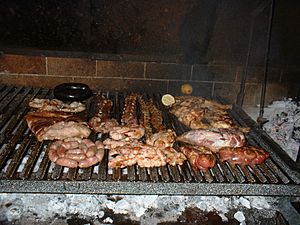

- South American cuisine has many rich food products from the middle of the continent, especially the Amazon basin. The Amazon region provides lots of fresh fish and tropical fruits. In countries like Peru, there is a strong influence from the Inca empire and their cooking. Potatoes and plants like quinoa are often grown. The Pacific Ocean along the western coast provides many types of seafood. Many plains on the continent are good for growing lots of food. In Patagonia (southern Chile), people raise lamb and hunt venison. King crab is caught at the southern end of the continent. Tuna and tropical fish are caught all around South America. Lobster is also caught in large amounts near the Juan Fernández. In Brazil, the most traditional dish is feijoada.
-
- Argentinian cuisine mixes local foods with influences from Mediterranean cultures. These include Italian, Spanish, and Arabic populations. Argentina has a lot of livestock and farm products.
- Bolivian cuisine
- Brazilian cuisine varies greatly by region, just like Brazil itself. The natural crops in each region add to its unique flavors. Some typical dishes are caruru, made with okra, onion, dried shrimp, and toasted nuts cooked in palm oil. Another is moqueca capixaba, a slow-cooked fish dish with tomato, onion, garlic, and cilantro.
- Chilean cuisine mainly comes from mixing Spanish cooking with traditional Chilean ingredients. Later, it was influenced by other European foods, especially from Germany, Italy, Croatia, France, and the Middle East. Chile's long coastline and its connection to the sea add many ocean products to its food. The country's waters have unique fish and shellfish like the Chilean sea bass and loco.
- Colombian cuisine refers to the cooking traditions of Colombia. Like other parts of its culture, Colombian food changes among its many regions. Colombians usually eat three meals a day: a big breakfast, a medium lunch, and a light dinner. Colombian coffee is famous for its great taste.
- Ecuadorian cuisine is diverse, changing with how high up a place is and what can be grown there. Pork, chicken, beef, and cuy are popular in the mountain regions. They are served with many carbohydrate-rich foods like rice, corn, and potatoes. A popular street food in the mountains is hornado, which is roasted pig served with potatoes.
- Paraguayan cuisine is similar to the foods in Uruguay and the Falkland Islands. Meats, vegetables, manioc, maize, and fruits are common. Barbecuing is a cooking method and a social event, known as Asados.
- Peruvian cuisine shows local cooking practices and ingredients. It also has influences from Spanish, Chinese, Italian, German, West African, and Japanese foods due to immigration. Many traditional foods like quinoa, kiwicha, chili peppers, and different roots have become more popular recently. This shows a renewed interest in native Peruvian foods and cooking methods.
-
-
- Peruvian-Chinese cuisine (chifa)
-
- Uruguayan cuisine is based on its European roots, especially Mediterranean food from Italy, Spain, Portugal, and France. It also has influences from Germany, Britain, Africa, and indigenous cultures. The national drink is Grappamiel.
- Venezuelan cuisine varies greatly from one region to another. This is because of its location, diverse resources, and the many cultures of the Venezuelan people. However, its traditional and modern food has strong ties to its European history.
- South American foods and dishes
-
Cebiche, a seafood dish popular in Central and South America, especially in Peru.
-
A typical Brazilian Feijoada, a stew of beans with beef and pork.
-
"Fish in a box", fresh fish served with Mediterranean vegetables in a Montevideo, Uruguay restaurant.
-
Bandeja paisa, a typical meal popular in Colombian cuisine. It includes red beans with pork, white rice, ground meat, chicharon, fried egg, plantain, chorizo, arepa, hogao sauce, morcilla, and avocado.
Caribbean Cuisine
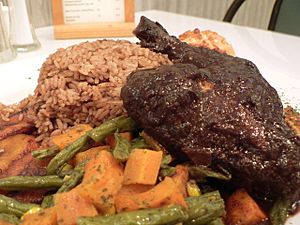
- There isn't just one Caribbean cuisine. Instead, there are different types based on European colonization. One type comes from areas colonized by Western European countries like Britain, France, and the Netherlands. The other type comes from Spanish-speaking areas, similar to Central and South America. Both types mix European influences with Native American and West African traditions.
The dishes in the former British and French islands are more diverse. This is because these islands often changed colonial owners (British, French, Dutch, Spanish). Also, many different groups of people were brought to work on plantations, including people from India, China, and Portugal. Even within the same colonial groups, there is diversity. For example, Trinidad and Jamaica were both British colonies and have similar cooking styles. However, Trinidad has a wider range of dishes due to its very different population mix. Across the wider Caribbean region, the main similarities are the fruits, vegetables, and ingredients used. Root vegetables, plantains, beans, rice, fish, and seafood are common everywhere. After independence and with globalization in the 1990s, cultural and food similarities between the former British, French, and Dutch islands became even stronger.
-
- Puerto Rican cuisine
- Trinidad and Tobago cuisine
- Regional Caribbean foods:
-
-
- Black Cake, similar to English Christmas pudding, is served in some areas, especially for special events.
- Callaloo
- Scotch bonnet pepper
-
Latin American Cuisine
- Latin American cuisine includes influences from all over the world. Most of these came from colonization and the mixing of Native American, European immigrant, and African slave cultures. Later waves of immigration, some due to wars like World War II, also added to this mix. These immigrants mainly came from Central and Eastern Europe, and from East Asia (like China and Japan).
- Central American cuisine – see above
- South American cuisine – see above
- Caribbean cuisine – see above



